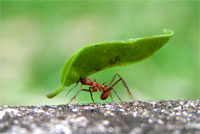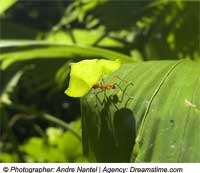|

The Acromyrmex and Atta ants have much in common anatomically; however, the two can be identified by their external differences. Atta ants have 3 pairs of spines and a smooth exoskeleton on the upper surface of the thorax while Acromyrmex have 4 pairs and a rough exoskeleton.
 
Different species of Leafcutter ants use different species of fungus, but all of the fungi the ants use are members of the Lepiotaceae family. The ants actively cultivate their fungus, feeding it with freshly-cut plant material and maintaining it free from pests and molds. This symbiotic relationship is further augmented by another symbiotic partner, a bacterium that grows on the ants and secretes chemicals, or secondary metabolites, which protect the fungus from molds that would feed on the fungus - essentially the ants use portable antimicrobials. When the ants happen to bring back toxic leaves, the fungus secretes a chemical that warns the ant not to collect any more of that type of leaf.
A mature Leafcutter colony can contain more than 8 million ants, mostly sterile female workers. They are divided into castes, based mostly on size, that perform different functions. Acromyrmex and Atta exhibit a high degree of biological polymorphism, five castes being present in established colonies - minims, minors, mediae and majors. Majors are also known as soldiers or dinergates. Atta ants are more polymorphic than Acromyrmex, meaning that there is comparatively less differential in size from the smallest to largest types of Acromymex.
Minims are the smallest workers, and tend to the growing brood or care for the fungus gardens. Head width is less than 1 mm.
Minors are slightly larger than minima workers and are present in large numbers in and around foraging columns. These ants are the first line of defense and continuously patrol the surrounding terrain and vigorously attack any enemies that threaten the foraging lines. Headwidth are around 1.8-2.2 mm
Mediae are the generalized foragers, who cut leaves and bring the leaf fragments back to the nest.
Majors are the largest worker ants and act as soldiers, defending the nest from intruders, although there is recent evidence that majors participate in other activities, such as clearing the main foraging trails of large debris and carrying bulky items back to the nest. The largest soldiers (Atta laevigata) may have total body lengths up to 16 mm and head widths of 7 mm.
When the ants are out collecting leaves, they are at risk of being attacked by the phorid fly, a parasitic pest which lay eggs into the crevices of the worker ants head. Often a minim will sit ont the worker ant and ward off any attack.
The nests of mature Atta colonies are well engineered, with thousands of underground chambers extending downwards more than 6 meters in depth. The central nest mound itself may be 30 meters in diameter, and have numerous 0.3 meter diameter feeder mounds extending outwards to a radius of 80 meters
 A Leafcutter ant colony with millions of workers produces copious amounts of waste. In order to prevent the spread of diseases and the rise of pathogenic pests in their gardens, Leafcutter ants have developed one of the most advanced waste management systems in nature. Waste products from the gardens and dead members of the colony are segregated away from the main nest by specialized "waste workers". Transporters carry the waste to garbage heaps, where other workers who live exclusively in the heap turn over the growing pile in order to accelerate decomposition. A Leafcutter ant colony with millions of workers produces copious amounts of waste. In order to prevent the spread of diseases and the rise of pathogenic pests in their gardens, Leafcutter ants have developed one of the most advanced waste management systems in nature. Waste products from the gardens and dead members of the colony are segregated away from the main nest by specialized "waste workers". Transporters carry the waste to garbage heaps, where other workers who live exclusively in the heap turn over the growing pile in order to accelerate decomposition.

Leafcutter ants comprise two genera — Atta and Acromyrmex — with a total of 39 species, some of which are major agricultural pests. For example, some Atta species are capable of defoliating an entire citrus tree in less than 24 hours.
All text is available under the terms
of the GNU Free Documentation License
|
